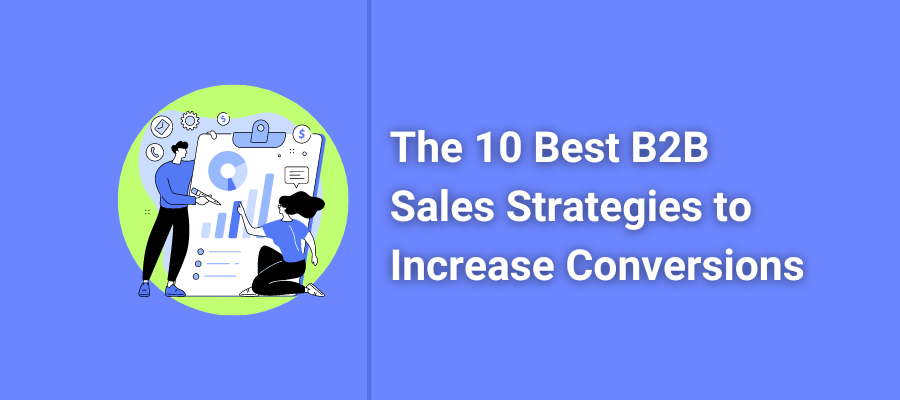Looking to ramp up your conversion rates with top-tier B2B sales strategies? You’re exactly where you need to be. Whether it’s about reshaping an existing sales approach or developing a new one from the ground up, this guide is your valuable resource in navigating the complex world of B2B sales.
When it comes to B2B sales, it’s obvious that having a skilled team and being a savvy salesperson is fundamental. But what really sets the stage for success? The answer is a well-structured, actionable B2B sales strategy.
In this article, we will walk you through what a sales strategy is and provide helpful tactics tailored to today’s B2B sales professionals. Our goal is to provide you with practical strategies that can help you meet sales goals and increase conversions.
What is a B2B Sales Strategy?
Ever wondered what a B2B sales strategy is all about? Or think it’s too complex? Let’s simplify it. A B2B sales strategy at its core is like a game plan or a roadmap for your sales team. It’s the series of steps they follow to bring in new customers. Think of it as your guide for the whole sales process, starting from finding potential clients to finally making a sale. Here’s what typically goes into it:
- Targeting and Outreach: This is where you figure out which companies could really use your product or service and then work out the best ways to get in touch with them.
- Positioning and Messaging: It’s all about how you tell potential clients about your product or service in a way that makes sense to them and meets their specific business needs.
- Competitive Analysis: Understanding how your offerings stack up against competitors and using this insight to improve your sales approach.
In the realm of B2B sales, strategies can vary widely. The choice of strategy depends on factors like your market, product type, and the nature of your potential clients. Overall, a B2B sales strategy is about more than just selling; it’s about creating meaningful business relationships that lead to long-term success for both your company and your clients.
Why Do You Need a B2B Sales Strategy?
Now that we have a clearer understanding of what a sales strategy entails, you might be wondering why it’s such a big deal. Well, if you like making sales, you need a strong sales strategy. Think of it this way: just as a builder needs a blueprint to construct a sturdy building, a sales team needs a sales strategy to build a successful business. It’s the foundation upon which all your sales efforts are based. Without it, you’re essentially navigating the complex world of sales without a map, which can lead to missed opportunities and wasted efforts.
- Businesses with a formal sales process see 28% higher revenue than those without one. (CSO Insights)
- 73% of customers expect companies to understand their unique wants and needs.
The Difference Between a Sales Strategy and a Sales Plan
It can get confusing trying to differentiate between a sales strategy and a sales plan, as they often seem to overlap. But, it’s crucial to understand that while they are closely related, they serve distinct functions in the sales process. Think of a sales strategy as your ‘what’ and ‘why’ – it’s the general approach and reasoning behind your sales efforts. It defines your target market, outlines your unique value proposition, and sets the overall direction based on market research and business goals.
On the other hand, a sales plan is the ‘how’. It’s a practical, detailed roadmap of the specific actions your sales team needs to take to implement the strategy. The sales plan gets into the weeds of day-to-day operations, translating the broader vision of your sales strategy into actionable steps.
How Can a Sales Strategy Help Increase Conversions?
When we’re talking about increasing conversions in B2B sales, a solid sales strategy isn’t just helpful—it’s crucial. At its core, a sales strategy fuels business growth by aligning what you offer with what your customers need. It’s the key to turning prospects into actual customers. Here’s why a well-defined sales strategy is essential for boosting your conversion rates:
- Better Lead Qualification: A good sales strategy helps you identify and target leads that are more likely to convert. By focusing on prospects that fit your ideal customer profile, you reduce time spent on less promising leads and increase your chances of successful conversions.
- Enhanced Sales Efficiency: By having a strategy, your sales efforts are more organized and focused. This efficiency prevents wasted resources on low-potential leads and directs energy towards opportunities with a higher likelihood of conversion.
- Informed Decision-Making: With a sales strategy, decisions are made based on a clear understanding of market trends, customer feedback, and sales performance data. These informed decisions help in fine-tuning your sales process and tactics, leading to better conversion rates.
Now that we’ve discussed the importance of a sales strategy and how it can increase conversions, you might be eager to learn how to put this into action. What specific tactics can you employ to see these benefits in your sales numbers? In the next section, we’ll dive into the specific strategies that you can implement to take your B2B sales to the next level.
The 10 Best B2B Sales Strategies to Increase Conversions
In the complex world of B2B sales, implementing effective strategies is key to increasing conversions. Here are 10 proven strategies to improve your sales approach and achieve better results.

1. Invest in Your Salespeople

The true power of a B2B sales strategy lies in the hands of those who execute it: your sales team. Think of it like this: if your salespeople are more knowledgeable, confident, and skilled, they’re going to be much better at selling your product or service. It’s pretty straightforward. So, why not invest in them?
For instance, by investing in sales training, a salesperson can sharpen their sales skills, making each customer interaction more likely to result in a successful closing. Here are a few more ways you can invest in your salespeople:
- Comprehensive Training Programs: Implement regular training sessions focusing on advanced sales techniques, product expertise, and customer service excellence.
- Ongoing Mentoring: Establish a culture of continuous learning by pairing less experienced salespeople with seasoned mentors.
- Incentive Programs: Create incentive programs that reward salespeople for not just reaching, but exceeding their sales targets.
Your sales team’s success is directly tied to your success. By investing in your salespeople, you show that you care about their growth and career development. This investment can make them feel valued and appreciated, leading to a positive work environment. When your sales team is engaged, skilled, and motivated, they are more effective at converting prospects into loyal customers, directly boosting your conversion rates.
| Did You Know? Highly engaged workforces outperform their peers by 147% in earnings per share. |
Related: Why It’s Important For Your Employees to Love Their Job
2. Identify your ideal customer

Identifying your ideal customer is a fundamental step in refining your B2B sales strategy. This process involves pinpointing exactly who your product or service is for and understanding their specific needs, behaviors, and pain points. By focusing on your ideal customer, you can tailor your sales and marketing efforts to address the right audience, making your approach more effective and efficient. Below are helpful steps to identify your ideal customer:
- Analyze Existing Customers: Look at your current customer base to identify common characteristics and patterns. Which types of businesses benefit most from your product or service? What problems are you solving for them?
- Create Buyer Personas: Develop detailed buyer personas based on your analysis. These personas should include industry, company size, decision-making process, challenges, and goals. Personas help in visualizing and understanding your ideal customer.
- Focus Sales Efforts: Use this information to focus your sales efforts on prospects that match your ideal customer profile. Tailoring your approach to these specific customers increases the likelihood of successful conversions.
When you know who your ideal customer is, you can make more targeted and relevant sales pitches. This focus not only saves time and resources but also increases your chances of closing deals.
3. Develop a Customer-Centric Approach

A customer-centric approach is all about putting your customers’ needs and experiences at the heart of your sales strategy. This method involves more than just understanding what your customers want; it’s about aligning your entire sales process, from the initial contact to the final sale, with their preferences and requirements. When customers feel that their specific needs are being addressed and valued, they’re more likely to engage with your business and eventually make a purchase. Below are some key elements of a customer-centric strategy:
- Know Your Customers: Really get to know your customers. What are their business challenges, goals, and pain points? Use this understanding to tailor your solutions to directly address their unique needs.
- Personalize Your Interactions: Every customer is different. Customize your communication and solutions to fit each customer’s specific situation. This personalized approach can significantly enhance customer engagement and trust.
- Act on Feedback: Show your customers that their opinions matter. Regularly collect feedback and make visible changes based on it. This not only improves your offerings but also builds a stronger, trust-based relationship with your customers.
By focusing on your customers’ specific needs and creating a sales experience tailored to them, you’re more likely to build a strong, trust-based relationship. This level of trust and personalized service makes customers more inclined to choose your business over competitors, leading to higher conversion rates.
4. Focus On Decision Makers

In B2B sales, time is money, and you want to ensure you’re talking to the right people – the decision-makers. These are the individuals who have the authority to say ‘yes’ to your pitch and sign off on purchases. Focusing your efforts on engaging with decision-makers can streamline your sales process and significantly increase your conversion rates.
- Identify Decision Makers: Don’t spend time on the phone with someone who can’t make the final decision. Determine who your decision-makers are. Depending on the size and structure of the company, decision-makers may be executives, managers, or department heads.
- Tailor Your Communication: Once you know who the decision-makers are, tailor your communication to speak directly to their needs and concerns. Decision makers are typically looking for solutions that offer real value to their business, so highlight how your product or service can help achieve their specific goals.
- Build Relationships: Decision makers often rely on trust and credibility when making purchasing decisions. Focus on building a relationship with them, which might involve networking at industry events, arranging one-on-one meetings, or engaging through professional groups or forums.
By focusing on decision-makers, you’re ensuring that your sales efforts are targeted at the people who can actually move the needle. This approach not only saves time but also increases the likelihood of your pitch being considered seriously.
Related: How to Get Past Medical Billing Gatekeepers
5. Establish a Strong Online Presence

In the digital age, establishing a strong online presence is crucial for B2B sales success. It’s about more than just having a website; it’s about creating a digital identity that resonates with your target audience and builds your brand’s credibility. A strong online presence helps you reach a broader audience, engage with potential customers, and establish your business as an authority in your industry.
Social Media:
- Actively use platforms like LinkedIn, Twitter, and Facebook to connect with your audience.
- Share industry insights, company news, and thought leadership content to engage your followers.
- Utilize social media to network, build relationships, and understand your customers’ needs and preferences.

Content Marketing:
- Develop a robust content marketing strategy that includes blogs, whitepapers, eBooks, and videos.
- Provide valuable, informative, and relevant content that addresses your audience’s pain points and showcases your solutions.
- Use SEO best practices to enhance the visibility of your content in search engine results, making it easier for potential customers to find you.
A strong online presence places your business in front of potential customers where they spend a significant amount of their time: online. By consistently providing value through your digital channels, you build trust and recognition. This presence not only educates your potential customers about your products and services but also positions your brand as a go-to resource in your field. The result is a more engaged audience, higher brand visibility, and ultimately, increased conversion opportunities.
6. Align Sales and Marketing

Yes, we know, sales and marketing teams often seem like they’re on different planets. But here’s the thing: if you’re aiming for real success, getting these two to join forces is your golden ticket. When sales and marketing are aligned, it’s like creating a dream team that knows exactly what it takes to create a successful B2B Sales Strategy and maximize profits.
- Set Common Goals: Kick things off by setting goals that both sales and marketing care about. When both teams are shooting for the same targets, collaboration comes naturally.
- Frequent Chats: Encourage regular catch-ups between the two teams. Whether it’s over coffee or a quick Zoom call, these chats can work wonders. They help in syncing up strategies and keeping everyone in the loop.
Getting sales and marketing to play nice can seriously ramp up your conversion game. Marketing starts to bring in leads that are just right for what sales are pitching. And the sales team knows exactly how to take these well-nurtured leads across the finish line.
Related: Aligning Sales and Marketing to Generate Quality Leads
7. Embrace Account-Based Marketing

Account-Based Marketing (ABM) isn’t just a fancy buzzword; it’s a focused approach that can really rev up your sales engine. Think of it as creating a custom sales plan for each of your key accounts. Instead of a one-size-fits-all B2B sales strategy, ABM is about tailoring your efforts to fit the specific needs and characteristics of individual clients or customer segments.
- Identify Key Accounts: Start by pinpointing which accounts are most valuable to your business. These are the clients that have the potential for high revenue, strategic value, or long-term partnerships.
- Customized Marketing Strategies: For each key account, develop a personalized marketing strategy. This might involve creating tailored content, personalized email campaigns, or even customized product offerings.
- Track and Adapt: Regularly review how these accounts are responding to your ABM efforts. Be ready to tweak and adapt your strategies for maximum impact.
ABM works because it’s personal and targeted. When a key account sees that you understand their unique challenges and needs and that you’re crafting solutions just for them, they’re more likely to engage and invest in what you’re offering.
8. Develop a Lead-Nurturing Plan

Developing a lead-nurturing plan is all about patience and persistence. It’s a long game, where you gently guide potential customers down the sales funnel without rushing them (nobody likes a pushy salesperson). The key is to build a relationship and establish trust, so when they’re ready to buy, you’re the first one they think of.
- Tailored Communication: Regularly send your leads informative and relevant content based on their interests and stage in the buying process. This could be through targeted emails, educational webinars, or insightful blog posts.
- Follow-Up B2B Sales Strategies: Implement a systematic follow-up process. Regular check-ins via email or phone calls can keep you on their radar without being pushy. (How to Write a Follow-up Sales Email that Closes the Deal)
- Personalization is Key: Customize your interactions based on what you know about each lead. Personal touches can make a big difference in how your messages are received.
By nurturing leads effectively, you’re not just capturing leads, but also effectively guiding them toward making a purchase.
Related: How to Nurture B2B Leads
9. Engage Current Clients

Don’t overlook your current clients when finalizing your sales strategies. Your current clients can be a goldmine for new business opportunities. They already know and trust your product or service, making them perfect candidates for referrals and upselling.
- Ask for Referrals: Encourage satisfied clients to refer others to your business. Sometimes, a simple ask can lead to new opportunities.
- Upsell Opportunities: Keep an eye out for opportunities to upsell additional products or services that complement what your clients already have. Ensure these offers add real value to their existing setup.
Your current clients can be a rich source of increased conversions. Engaging them with new offers and encouraging referrals are excellent ways to leverage existing relationships.
10. Measure, Adapt, Integrate

Consistently measuring your sales performance isn’t just about keeping score; it’s a vital part of a dynamic sales strategy. Understanding how well your methods are working allows you to adapt and evolve your approaches in real time, ensuring that your sales tactics remain effective and relevant.
- Measure Your Performance: By regularly analyzing key sales metrics such as conversion rates, deal sizes, and sales cycle lengths, you gain crucial insights into the effectiveness of your strategies.
- Adjust as Needed: Armed with this data, you can make informed decisions to modify or change aspects of your sales approach. This could mean shifting focus to more profitable market segments, adjusting your sales pitch, or reevaluating the channels you use.
- Leverage Technology & Tools: After measuring and adjusting your strategy, take the next step by integrating innovative technology and tools. Utilize CRM systems for detailed insights, analytics for fine-tuning your approach, and automation to enhance efficiency. This is where you leverage the digital edge to keep your sales strategy not just current, but cutting edge.
Adapting your approach based on data and harnessing the power of technology means your sales efforts are always aligned with the most effective practices, which is essential for continually improving your conversion rates.
Final Thoughts on B2B Sales Strategies
Well, there you have it – a comprehensive look at the top strategies to elevate your B2B sales game. These strategies are your toolkit for navigating the complex and changing world of B2B sales. We hope Implementing them will not only help boost your sales conversions but also position your business for sustained success.
Take Your B2B Sales to the Next Level
Ready to put these strategies to the test? Let us help! At 360Connect, we connect suppliers like you with high-quality buyers. Join our supplier network and experience a new level of sales success!

